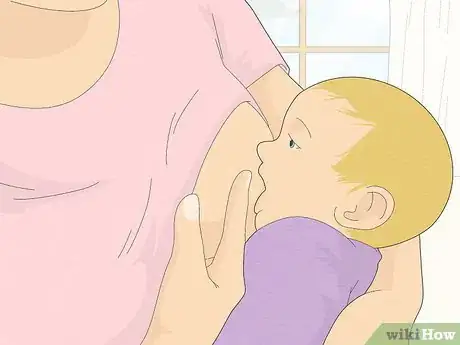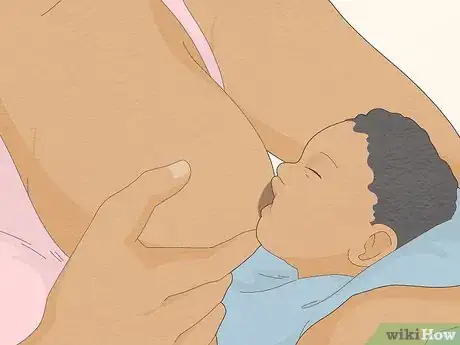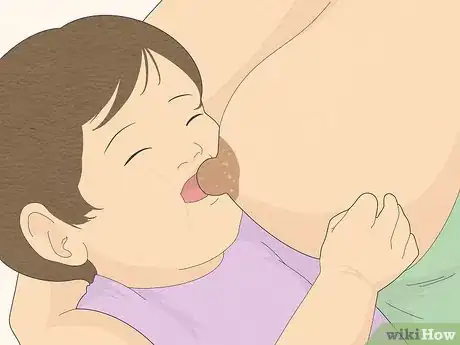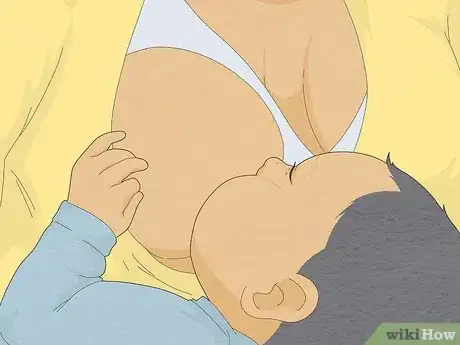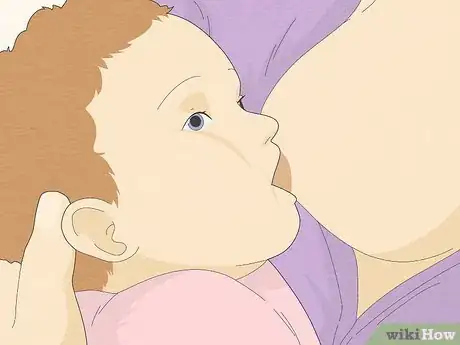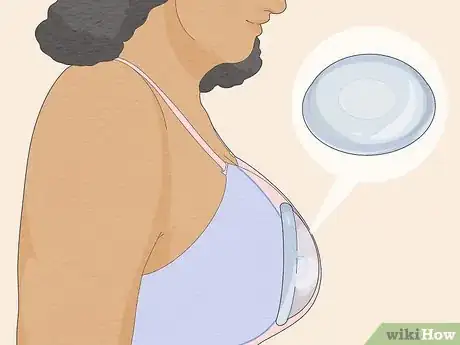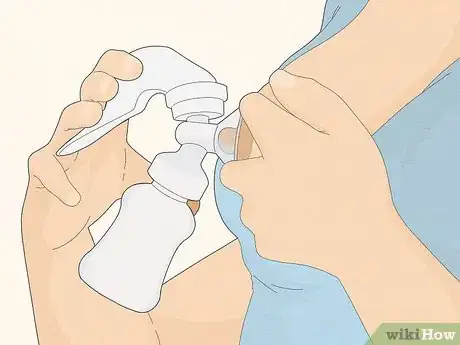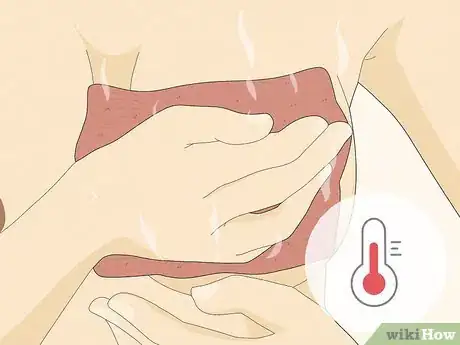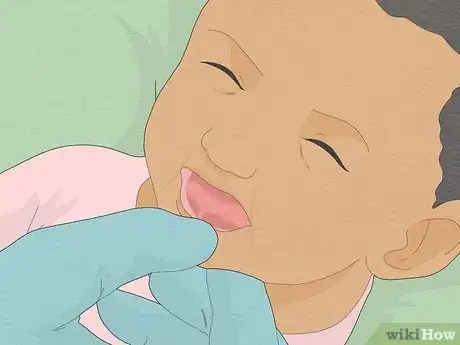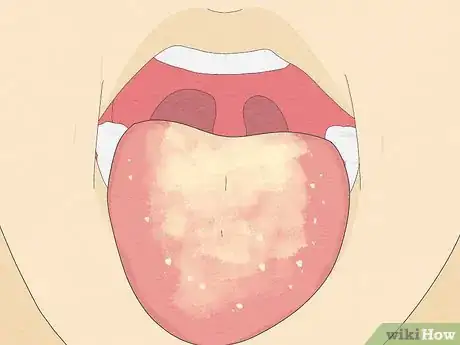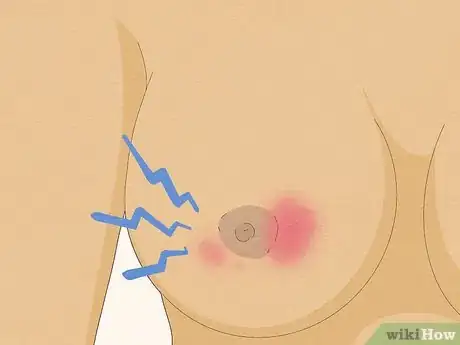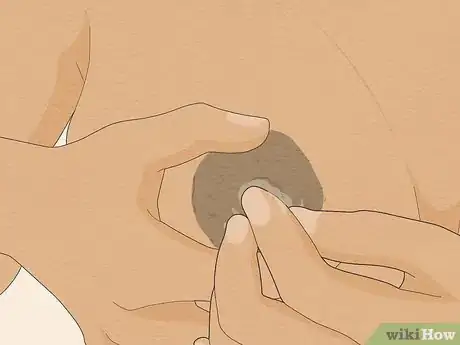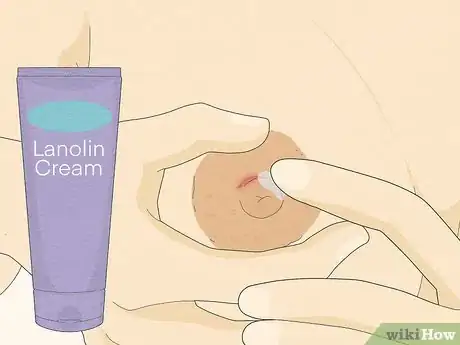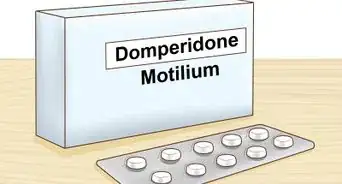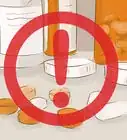This article was co-authored by Carrie Noriega, MD. Dr. Noriega is a Board Certified Obstetrician & Gynecologist and medical writer in Colorado. She specializes in women’s health, rheumatology, pulmonology, infectious disease, and gastroenterology. She received her MD from the Creighton School of Medicine in Omaha, Nebraska and completed her residency at the University of Missouri - Kansas City in 2005.
This article has been viewed 59,790 times.
Breastfeeding is a great way to bond with your baby and ensure they get the best nutrition in their early years. Some women have a difficult time nursing their babies due to sore or cracked nipples and discomfort, especially during the first week of nursing. While it is common for new mothers to experience breast soreness and tenderness early in the nursing process, there are ways to help remedy this issue or avoid it.
Steps
Having a Good Feeding Session
-
1Note early hunger cues in your baby. Rather than wait until your baby starts crying or really pulling at your breasts, you should watch for early hunger cues from your baby and try to feed them as soon as possible. A very hungry baby can grab at your nipples and suck on them hard, leading to sore nipples. Feed your baby as soon as they start to get fussy or close to their normal feeding time to avoid sore nipples.[1]
- For newborns, you should try to do eight to twelve feeds every 24 hours, keeping the feedings consistent and close to the same time. This will prevent your baby from sucking too hard due to hunger.
- If your newborn baby is not feeding every three hours, you should hand-express out the milk or pump the milk out into bottles. This will prevent your breasts from becoming engorged. Engorged breasts can lead to the development of flat nipples, which will make it more difficult for your baby to latch on and feed.
-
2Breastfeed on the least sore side first. If your breasts are feeling tender, you may want to get your baby to feed on the side that is not as sore first. This will give the sore breast a break.[2]
- This will also prevent your sore breast from becoming more irritated and allow your baby to get used to feeding from both breasts.
Advertisement -
3Get into a comfortable, supported position. Sit on a couch or a chair and use pillows to support your lower back, as well as your arms. You should support your feet on a footrest or on a stack of pillows. This will help to make you and your baby feel comfortable during the feeding.
-
4Place the baby close to you, with their mouth and nose facing your breast. Make sure your baby is tucked up close to you, with your tummies touching each other. Place a supporting hand or arm behind your baby’s shoulders, rather than their head. Their face should be facing towards your nipple. Your baby should not have to turn or adjust their head to reach your breast. It should be easily accessible.
- Another way to view this positioning is to ensure your nipple is pointed towards your baby’s nose. This will allow them to open their mouth and tip their head back, sliding the nipple towards the roof of their mouth.
-
5Use your hand to support your breast. Cup your breast with your free hand and place it close to your baby’s mouth. It should not be pressing on your baby’s chin or be far away from your baby’s mouth. This will allow your baby to move towards your breast and drive their chin into your breast.
-
6Allow your baby to self-latch. Most babies will move their heads towards their mother’s breasts and latch on their own. You baby may bob their head a little and consider before doing this, but self-latching is one the best ways to ensure a pain free and effective latch.[3]
- If your baby does not seem to be able to self-latch, you can encourage them to open their mouth wide by using your nipple to tickle their lips. Say “open” as you do this and make sure your breast is almost touching their nose. They should then allow you to attach your breast to their mouth.
-
7Make sure your baby latches on correctly. Many babies can have a shallow latch, where they do not latch onto your breast properly. An improper latch can lead to a sore nipple. Check that your baby is latched on correctly to your breast by checking that their mouth is wrapped around your entire areola and their lips are pursed outward around your areola.[4]
- You should also make sure your baby maintains an open mouth during the feeding and their chin is indenting the lower portion of your breast.
-
8Reposition your baby if your nipple starts to hurt. If you start to feel any discomfort or pain once your baby latches on to your breast, you should re position their mouth on your breast. Try to do this while they are nursing by pressing on your baby’s shoulder lightly to bring their closer to you. You can also use your free hand to tip their head back a little more or shift their position against your body slightly.[5]
- If you need to remove your baby from your breast at any time during the feeding, use a clean finger to do this. Place the finger into the corner of your baby’s mouth or between your baby’s gums to break the seal between your baby’s mouth and your breast. You can also try pulling down lightly on your baby’s chin or pressing down on your breast, next to your baby’s mouth, to break the seal.[6]
- Never just pull the baby off without breaking the suction first. This can damage the nipple.
Preparing for the Breastfeeding Session
-
1Let your breasts air out. Exposing your breasts to air will also help them stay dry and possibly make breastfeeding less uncomfortable.[7]
- You can buy feeding bras that are made of natural, breathable fibers so they do not irritate your breasts. They are usually also made so you can unhook them easily for feeding time.
- You can also buy breast shells, which are donut shaped plastic shells that you can place on your breasts to protect your nipples. These can be placed inside your bra or your shirt to protect sore nipples.
-
2Massage your breasts with your hands. You can also soften breasts to prepare for the feeding by using your hands to gently massage them. Do this a few minutes before feeding time so there is stimulation of your breast milk.[8]
- Another option is to pump your breasts for a few minutes using a hand pump to get the milk flowing. This may then make your nipples less sore and sensitive during feeding.
- This can also help elevate flat nipples and allow the baby to latch better to help prevent sore nipples.
-
3Have a warm shower. Exposing your body to a warm environment can help to stimulate milk production in your breasts. Some mothers will have a brief warm shower right before feeding time.[9]
- You can also try applying a warm towel to your breasts to soothe any discomfort and help stimulate milk flow.
-
4Do relaxation techniques. Staying calm and relaxed before and during the feeding can help to make breastfeeding less painful and uncomfortable. You may do some deep breathing, where you breathe in and out deeply for six to eight breaths, or a five minute meditation, where you sit in silence for five minutes. A calm and relaxed mindset can help take the stress out of breastfeeding.[10]
-
5Express a small amount of milk right before the feeding. Try to do this by lightly squeezing your breasts with your hands. Expressing a small amount of milk before feeding can help to encourage milk flow and activate the let down reflexes in your breasts. Your baby will then do less hard sucking, and put less stress, on your breasts during feeding.[11]
- Avoid using a strong breast pump to do this, as breast pumps can make your nipples feel sore or become cracked.
Treating Sore or Cracked Nipples
-
1Have your doctor check if your baby is tongue tied. A baby with a tongue-tie has difficulty lifting their tongue or moving forward normally. This can lead to issues during breastfeeding, as they cannot extract milk from your breast effectively. They may end up pushing your nipple up with their tongue, which can cause pain to their palate and discomfort on your nipple.[12]
- You can check to see if your baby can stick their tongue out past their bottom lip. You should also note if they can lift their tongue to the roof of their mouth when they cry. If they cannot make these movements, you should have your doctor check them for tongue-tie.
- If your baby has tongue-tie, your doctor can clip the membrane that is restricting your baby’s tongue. This can then lead to more effective feeding sessions with your baby.
-
2Allow the doctor to test you and your baby for thrush. Thrush is a fungal infection that can infect you and your baby. Thrush can cause irritation and redness on your nipples, as well as cracks and white patches. It can also appear in your baby’s mouth as white patches. Thrush can also affect your milk ducts, making it difficult and painful to breastfeed your baby properly.[13]
- Your doctor can confirm you have thrush and prescribe treatment.
-
3Get sore or cracked nipples checked for any infections. If your nipples become very sore and cracked while you are breastfeeding, you get your doctor to check if they are infected. Your doctor may recommend safe, topical medication to treat infected nipples.[14]
- If you have a breast infection, known as mastitis, your doctor can give you oral antibiotics that are safe for use while you are breastfeeding.
-
4Use your breast milk on any cuts or sore areas. If you already have cracks or sore areas developing on your nipples, you can use your own breast milk to help soothe them. Take your finger and rub a small amount of breast milk on your breasts before and after the feeding to encourage healing.[15]
- Avoid using any irritating substances on your nipples, such as soap or shampoo that contains alcohol or creams that contain irritating ingredients. Do not use cream that contains Vitamin E, as this can be toxic for your baby.[16]
- You should also be very gentle when cleaning your breasts in the shower. Use mild antibacterial soap and soft towels so your nipples do not become more irritated or sore.
-
5Apply a soothing compress on sore nipples. If your nipples are very sore, you can apply a soothing warm compress (a clean washcloth soaked in lukewarm water) on your nipples to reduce any swelling or discomfort.
- You can also try using medical grade lanolin ointment on your nipples to help with soreness or cracking; however, studies have shown that breast milk is more effective for sore, cracked nipples than lanolin ointment.[17]
- You can take a mild pain reliever 30 minutes prior to nursing if your nipples are painful. Mild pain relievers are considered safe for breastfeeding. If you have any concerns, talk to your doctor before taking any over-the-counter medications.
- Do not apply teabags to cracked, sore nipples, as this is a folk remedy that has been shown to be ineffective.
References
- ↑ https://www.todaysparent.com/baby/breastfeeding/how-to-treat-sore-nipples/
- ↑ https://www.breastfeeding.asn.au/bf-info/common-concerns%E2%80%93mum/sore-cracked-nipples
- ↑ https://www.todaysparent.com/baby/breastfeeding/how-to-treat-sore-nipples/
- ↑ http://americanpregnancy.org/breastfeeding/latch/
- ↑ https://www.todaysparent.com/baby/breastfeeding/how-to-treat-sore-nipples/
- ↑ http://www.medelabreastfeedingus.com/tips-and-solutions/115/sore-nipple-management
- ↑ https://www.todaysparent.com/baby/breastfeeding/how-to-treat-sore-nipples/
- ↑ http://www.medelabreastfeedingus.com/tips-and-solutions/115/sore-nipple-management
- ↑ http://www.medelabreastfeedingus.com/tips-and-solutions/115/sore-nipple-management
- ↑ http://www.medelabreastfeedingus.com/tips-and-solutions/115/sore-nipple-management
- ↑ https://www.breastfeeding.asn.au/bf-info/common-concerns%E2%80%93mum/sore-cracked-nipples
- ↑ https://www.todaysparent.com/baby/breastfeeding/how-to-treat-sore-nipples/
- ↑ https://www.nct.org.uk/parenting/sore-nipples
- ↑ http://www.medelabreastfeedingus.com/tips-and-solutions/115/sore-nipple-management
- ↑ https://www.todaysparent.com/baby/breastfeeding/how-to-treat-sore-nipples/
- ↑ http://www.medelabreastfeedingus.com/tips-and-solutions/115/sore-nipple-management
- ↑ http://www.ncbi.nlm.nih.gov/pubmed/16127520

